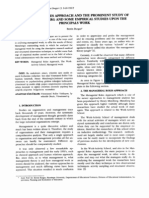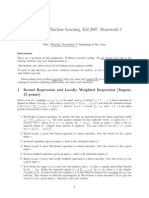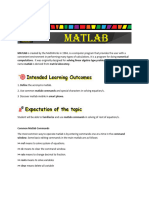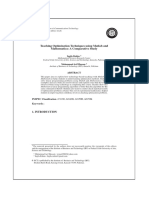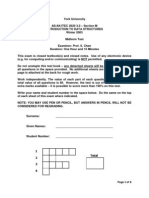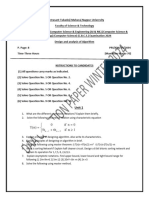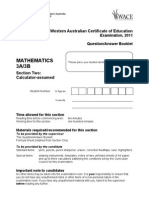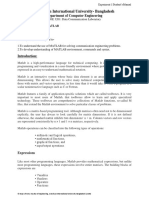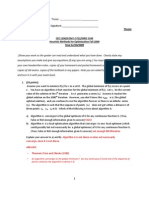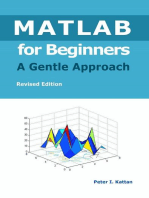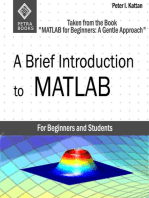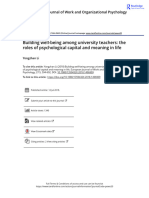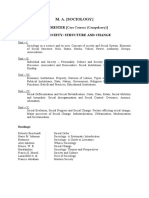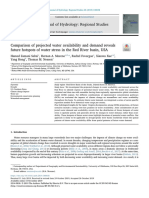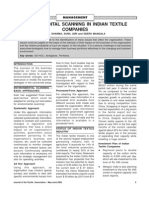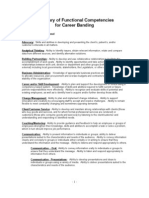Exam Spring 10
Exam Spring 10
Uploaded by
edgardfjCopyright:
Available Formats
Exam Spring 10
Exam Spring 10
Uploaded by
edgardfjCopyright
Available Formats
Share this document
Did you find this document useful?
Is this content inappropriate?
Copyright:
Available Formats
Exam Spring 10
Exam Spring 10
Uploaded by
edgardfjCopyright:
Available Formats
University of Wisconsin Madison
Computer Sciences Department
CS 760 - Machine Learning
Spring 2010
Exam
11am-12:30pm, Monday, April 26, 2010 Room 1240 CS CLOSED BOOK (one sheet of notes and a calculator allowed)
Write your answers on these pages and show your work. If you feel that a question is not fully specified, state any assumptions you need to make in order to solve the problem. You may use the backs of these sheets for scratch work. If you use the back for any of your final answers, be sure to clearly mark that on the front side of the sheets. Neatly write your name on this and all other pages of this exam.
Name
________________________________________________________________
Problem
Score
Max Score
1 2 3 4 5
______ ______ ______ ______ ______
20 20 20 20 20
TOTAL
______
100
Name: ______________________
Problem 1 Learning from Labeled Examples (20 points) You have a dataset that involves three features. Feature Cs values are in [0, 1000]. The other two features are Boolean-valued.
A Ex1 Ex2 Ex3 Ex4 Ex5 F T T F T B T F T F T C 115 890 257 509 753 Category false false true true true
a) How much information about the category is gained by knowing whether or not the value of feature C is less than 333?
b) How much information is there in knowing whether or not features A and B have the same value?
c) A knowledgeable reviewer says that the above data set was not very well pre-processed for nearest-neighbor algorithms. Briefly explain why a reviewer might say that.
Page 2 of 10
Name: ______________________
d) Assume a one-norm SVM puts weight = -3 on feature A, weight = 2 on feature B, and weight = 0 on feature C. What would the cost of this solution be, based on this questions five training examples? If you need to make any additional assumptions, be sure to state and briefly justify them.
The training examples repeated for your convenience: A Ex1 Ex2 Ex3 Ex4 Ex5 F T T F T B T F T F T C 115 890 257 509 753 Category false false true true true
Page 3 of 10
Name: ______________________
Problem 2 Aspects of Supervised Learning (20 points) a) Explain what active learning means. Also briefly describe how you might use Bagging to address the task of active learning.
b) Assume we have a supervised-learning task where the examples are represented by 26 Boolean features, A-Z. We guess that the true concept is of the form: Literal1 Literal2 Literal3
Where Literali is a one of the features A-Z or its negation and where a given feature can appear at most once in the concept (so C M A is a valid concept, but C M M is not). If 90% of the time we want to learn a concept whose accuracy is at least 95%, how many training examples should we collect?
Page 4 of 10
Name: ______________________
c) Assume that our learning algorithm is to simply (and stupidly) learn the model f(x) = maximum output value seen in the training set.
We want to estimate the error due to bias (in the bias-variance sense) of this algorithm, so we collect a number of possible training sets, where the notation NM means for input N the output is M (i.e., there is one input feature and the output is a single number). { 1 3, 2 2} { 4 5, 3 0 } { 2 2, 4 5 } { 3 0, 3 0 } { 2 2, 1 3 }
Based on this sample of possible training sets, what is the estimated error, due to this algorithms bias, for the input value of 2? Be sure to show your work and explain your answer.
Page 5 of 10
Name: ______________________
Problem 3 Reinforcement Learning (20 points) Consider the deterministic reinforcement environment drawn below (let =0.5). The numbers on the arcs indicate the immediate rewards. Once the agent reaches the end state the current episode ends and the agent is magically transported to the start state. The probability of an exploration step is 0.02.
start -3
-5 2 4 7
-1000
end
a) A one-step, Q-table learner follows the path start b end. On the graph below, show the Q values that have changed, and show your work to the right of the graph. Assume that for all legal actions, the initial values in the Q table are 6.
start
end
b) Starting with the Q table you produced in Part a, again follow the path start b end and show the Q values below that have changed. Show your work to the right.
start
end
Page 6 of 10
Name: ______________________
c) State and informally explain the optimal path from start to end that a Q-table learner will learn after a large number of trials in this environment. (You do not need to show the score of every possible path. The original RL graph appears below for convenience.) start end
d) Repeat Part c but this time assume the SARSA algorithm is being used. start end
e) In class and in the text, a convergence proof for Q learning was presented. If we use a function approximator, this proof no longer applies. Briefly explain why.
Here again is the version of the RL graph with the immediate rewards shown. -3 9
start
-5 2 4 7
-1000
end
Page 7 of 10
Name: ______________________
Problem 4 Experimental Methodology (20 points) a) Assume on some Boolean-prediction task, you train a perceptron on 1000 examples and get 850 correct, then test your learned model on a fresh set of 100 examples and find it predicts 80 correctly. Give an estimate, including the 95% confidence interval, for the expected accuracy on the next 100 randomly drawn examples.
b) Sketch a pair of learning curves that might result from an experiment where one evaluated whether or not a given feature-selection algorithm helped. Be sure to label the axes and informally explain what your curves show.
Why would a learning curve even be used for an experiment like this?
c) Assume you have trained a Bayesian network for a Boolean-valued task. For each of the test-set examples below, the second column reports the probability the trained Bayesian network computed for this example, while the third column lists the correct category. Example 1 3 2 4 5 Probability(Output is True) Correct Category 0.99 positive 0.81 negative 0.53 positive 0.26 negative 0.04 negative
Draw to the right of this table the ROC curve for this ensemble (it is fine to simply connect the dots, that is make your curve piece-wise linear). Be sure to label your axes.
Page 8 of 10
Name: ______________________
Problem 5 Miscellaneous Short Answers (20 points) Briefly define and discuss the importance in machine learning of each of the following: weight decay
definition:
importance:
kernels that compute the distance between graph-based examples [graph here is in the sense of arcs and nodes, as opposed to plots of x vs. f(x)]
definition:
importance:
structure search
definition:
importance:
State and briefly explain two ways that the Random Forest algorithm reduces the chances of overfitting a training set. i)
ii)
Page 9 of 10
Name: ______________________
Feel free to tear off this page and use it for scratch paper.
Page 10 of 10
You might also like
- For All Sanfoundry MCQ (1000+ MCQ) JOIN Telegram Group : Prev NextDocument368 pagesFor All Sanfoundry MCQ (1000+ MCQ) JOIN Telegram Group : Prev Nextsuraj rautNo ratings yet
- Numerical Methods With MATLAB - Recktenwald PDFDocument85 pagesNumerical Methods With MATLAB - Recktenwald PDFMustafa Yılmaz100% (1)
- Ass 1 Unit 26 16-17Document3 pagesAss 1 Unit 26 16-17Anonymous RzVl4YDC0% (1)
- DM WK 1Document13 pagesDM WK 1Gaston Dereck AlexNo ratings yet
- Mintzberg Managerial RolesDocument12 pagesMintzberg Managerial RolesJenno AttzsNo ratings yet
- CPSC 540 Assignment 1 (Due January 19)Document9 pagesCPSC 540 Assignment 1 (Due January 19)JohnnyDoe0x27ANo ratings yet
- Capital University of Science and Technology Department of Computer Science CS 3163: Design and Analysis of Algorithms (3) : Fall 2020Document4 pagesCapital University of Science and Technology Department of Computer Science CS 3163: Design and Analysis of Algorithms (3) : Fall 2020Malik NaveedNo ratings yet
- CS 540: Introduction To Artificial Intelligence: Final Exam: 8:15-9:45am, December 21, 2016 132 NolandDocument8 pagesCS 540: Introduction To Artificial Intelligence: Final Exam: 8:15-9:45am, December 21, 2016 132 NolandchemchemhaNo ratings yet
- CS316 Fall24 Midterm QuestionDocument11 pagesCS316 Fall24 Midterm Questionwilliamhe219No ratings yet
- Worksheet Classification1Document15 pagesWorksheet Classification1Partha Pritom GhoshNo ratings yet
- TextDocument9 pagesTextpsbr6m92hjNo ratings yet
- Data Mining FAQDocument4 pagesData Mining FAQAnuj GuptaNo ratings yet
- HW 3Document5 pagesHW 3AbbasNo ratings yet
- Lab 9Document2 pagesLab 9Maira SulaimanovaNo ratings yet
- Ex 6Document16 pagesEx 6api-322416213No ratings yet
- Introduction To MatlabmDocument56 pagesIntroduction To MatlabmGeorji kairuNo ratings yet
- CSE 331 Final Exam 3/18/13Document14 pagesCSE 331 Final Exam 3/18/13Aijin JiangNo ratings yet
- HW 1Document4 pagesHW 1sagar0596No ratings yet
- Midterm2012 SolDocument8 pagesMidterm2012 SolNishank ModiNo ratings yet
- 4 Teaching Optimization Techniques Using Matlab and Mathematica A Comparative StudyDocument9 pages4 Teaching Optimization Techniques Using Matlab and Mathematica A Comparative StudymaherkamelNo ratings yet
- Midterm - 2620 3.0Document9 pagesMidterm - 2620 3.0pepe_rozyNo ratings yet
- Unit 7 Assignment Problem: StructureDocument22 pagesUnit 7 Assignment Problem: StructuremonikachandraNo ratings yet
- CSE1020 Final SolutionDocument10 pagesCSE1020 Final SolutionAndreas Ivan MendesNo ratings yet
- Assignment 2 SpecificationDocument3 pagesAssignment 2 SpecificationRazinNo ratings yet
- DIT865 2018 Mar SolutionDocument9 pagesDIT865 2018 Mar SolutionEducation VietCoNo ratings yet
- Daa Question Paper Winter 2024Document8 pagesDaa Question Paper Winter 2024sahillanjewar294No ratings yet
- 1 Analytical Part (3 Percent Grade) : + + + 1 N I: y +1 I 1 N I: y 1 IDocument5 pages1 Analytical Part (3 Percent Grade) : + + + 1 N I: y +1 I 1 N I: y 1 IMuhammad Hur RizviNo ratings yet
- EE 559 Midterm From S11Document12 pagesEE 559 Midterm From S11chrisc885597No ratings yet
- Mathematics 3A3B Calculator Assumed Examination 2011 PDFDocument24 pagesMathematics 3A3B Calculator Assumed Examination 2011 PDFLachlan AlpNo ratings yet
- Exam 2018Document6 pagesExam 2018Liew ChengmingNo ratings yet
- Seon Joo Final 2Document14 pagesSeon Joo Final 2Shin PhanNo ratings yet
- DM Computer Second Year Study MaterialDocument522 pagesDM Computer Second Year Study Material43A Nitanshu ShahaneNo ratings yet
- CSE512 Fall19 HW4V1Document6 pagesCSE512 Fall19 HW4V1JaspreetSinghNo ratings yet
- MFound HW3Document4 pagesMFound HW3yiankaso96No ratings yet
- Answers For End-Sem Exam Part - 2 (Deep Learning)Document20 pagesAnswers For End-Sem Exam Part - 2 (Deep Learning)Ankur BorkarNo ratings yet
- Homework Set 3Document7 pagesHomework Set 3Arafath CherukuriNo ratings yet
- AP LAB-1 SyllabusDocument15 pagesAP LAB-1 SyllabusSUMEET KUMAR MONTINo ratings yet
- Quiz1 Solutions Quiz 1 SolnDocument7 pagesQuiz1 Solutions Quiz 1 Solnhasna.nafirNo ratings yet
- Data Communication EXP 1 Student ManualDocument10 pagesData Communication EXP 1 Student ManualMohammad Saydul AlamNo ratings yet
- 2022 Spring CS300 MidtermDocument9 pages2022 Spring CS300 MidtermyunajessiNo ratings yet
- CS771 IITK EndSem SolutionsDocument8 pagesCS771 IITK EndSem SolutionsAnujNagpal100% (1)
- Second Exam 2022 - 2023 (W - Solutions) - V1Document8 pagesSecond Exam 2022 - 2023 (W - Solutions) - V1butarros123No ratings yet
- Zhu - Multiclass Adaboost2009 PDFDocument12 pagesZhu - Multiclass Adaboost2009 PDFMichele FrederickNo ratings yet
- MIT6 094IAP10 Assn01Document12 pagesMIT6 094IAP10 Assn01Rosh OtojanovNo ratings yet
- IMP Questions ADADocument7 pagesIMP Questions ADAHeena BaradNo ratings yet
- Data Comm EXP 1 Instructor ManualDocument10 pagesData Comm EXP 1 Instructor ManualHellion HellionNo ratings yet
- Kami Export - ANAS ALANI - Unit 2 Test ReviewDocument4 pagesKami Export - ANAS ALANI - Unit 2 Test Review1608942No ratings yet
- COL 774: Assignment 2Document3 pagesCOL 774: Assignment 2Aditya KumarNo ratings yet
- Csca48 Final 2013wDocument20 pagesCsca48 Final 2013wexamkillerNo ratings yet
- Final 2009Document3 pagesFinal 2009eddie2490No ratings yet
- MTH3051 Introduction To Computational Mathematics Assignment 1. Long MultiplicationDocument3 pagesMTH3051 Introduction To Computational Mathematics Assignment 1. Long MultiplicationCameron SmithNo ratings yet
- Cse 321 HW04Document2 pagesCse 321 HW04tubaNo ratings yet
- Master of Business Administration-MBA Semester 1 MB0048 - Operations Research - 4 Credits (Book ID: B1631) Assignment Set - 1 (60 Marks)Document7 pagesMaster of Business Administration-MBA Semester 1 MB0048 - Operations Research - 4 Credits (Book ID: B1631) Assignment Set - 1 (60 Marks)Vikas WaliaNo ratings yet
- Principles Comm EXP 1 Student ManualDocument10 pagesPrinciples Comm EXP 1 Student ManualmushfiquelabibNo ratings yet
- Notes PDFDocument25 pagesNotes PDFDaaft PrickNo ratings yet
- CS 540: Introduction To Artificial Intelligence: Final Exam: 5:30-7:30pm, December 17, 2015 Beatles Room at EpicDocument11 pagesCS 540: Introduction To Artificial Intelligence: Final Exam: 5:30-7:30pm, December 17, 2015 Beatles Room at EpicchemchemhaNo ratings yet
- 1 RegressionDocument4 pages1 RegressionAgustin AgustinNo ratings yet
- MATLAB for Beginners: A Gentle Approach - Revised EditionFrom EverandMATLAB for Beginners: A Gentle Approach - Revised EditionRating: 3.5 out of 5 stars3.5/5 (11)
- A Brief Introduction to MATLAB: Taken From the Book "MATLAB for Beginners: A Gentle Approach"From EverandA Brief Introduction to MATLAB: Taken From the Book "MATLAB for Beginners: A Gentle Approach"Rating: 2.5 out of 5 stars2.5/5 (2)
- 2018. Building well-being among university teachers the roles of psychological capital and meaning in lifeDocument10 pages2018. Building well-being among university teachers the roles of psychological capital and meaning in lifeFrancisco Javier Diaz PincheiraNo ratings yet
- Competency Based Interview NotesDocument2 pagesCompetency Based Interview NotesSupratha DarwinNo ratings yet
- Book Review Rekha TalmakiDocument3 pagesBook Review Rekha TalmakiVibhuti PatelNo ratings yet
- Final Thesis Document-SEIFE B.Document132 pagesFinal Thesis Document-SEIFE B.Smart EngineeringNo ratings yet
- M. A. (Sociology) : I - SEMESTER (Core Courses (Compulsory) ) 1.1 Society: Structure and ChangeDocument5 pagesM. A. (Sociology) : I - SEMESTER (Core Courses (Compulsory) ) 1.1 Society: Structure and ChangeVenkata Sai MonishNo ratings yet
- Virtual Reality Platform For Sustainable Road Education Among Users of Urban Mobility in Cuenca EcuadorDocument11 pagesVirtual Reality Platform For Sustainable Road Education Among Users of Urban Mobility in Cuenca Ecuadorhoai phamNo ratings yet
- Regression AnalysisDocument9 pagesRegression AnalysisAlamin AhmadNo ratings yet
- Environment Agency (2015) Hydrometry and Telemetry - How To Perform Bathymetric Surveys Using An ADCPDocument30 pagesEnvironment Agency (2015) Hydrometry and Telemetry - How To Perform Bathymetric Surveys Using An ADCPsonantNo ratings yet
- LAB 9 - Bitumen Penetration OEL 1Document3 pagesLAB 9 - Bitumen Penetration OEL 12020890244No ratings yet
- The Effect of Fraud Triangle in Detecting Financial Statement FraudDocument14 pagesThe Effect of Fraud Triangle in Detecting Financial Statement FraudEzra viollaNo ratings yet
- Google's HRM - Training, Performance Management - Panmore InstituteDocument5 pagesGoogle's HRM - Training, Performance Management - Panmore InstituteNewton KumamNo ratings yet
- Journal of Hydrology: Regional Studies: SciencedirectDocument14 pagesJournal of Hydrology: Regional Studies: SciencedirectMendrakevNo ratings yet
- MM - II (MKT 5002) - Course OutlineDocument5 pagesMM - II (MKT 5002) - Course OutlineSomil GuptaNo ratings yet
- Environmental Analysis of Textile IndustryDocument6 pagesEnvironmental Analysis of Textile IndustryTanmay Varshney100% (1)
- Needs and Course DesignDocument38 pagesNeeds and Course DesignJaydenz AndersonNo ratings yet
- Academic Reading Practice Test 1Document11 pagesAcademic Reading Practice Test 1Gurpreet DhillonNo ratings yet
- TSLB 3113 PresentationDocument21 pagesTSLB 3113 PresentationStephanie LimNo ratings yet
- Cess Chapter 2 RRLDocument11 pagesCess Chapter 2 RRLpawatkorapatpranpatwaiNo ratings yet
- Discrepancy Theory Models of Satisfaction in IS ReDocument39 pagesDiscrepancy Theory Models of Satisfaction in IS ReXindy Imey PratiwiNo ratings yet
- Naspub SaraDocument25 pagesNaspub SaraSahara Ramadhani100% (1)
- Format For Course Curriculum: Annexure CD - 01'Document4 pagesFormat For Course Curriculum: Annexure CD - 01'Loolik SoliNo ratings yet
- Cebu Institute of Technology - University: Nursing Care PlanDocument7 pagesCebu Institute of Technology - University: Nursing Care PlanNine RavenNo ratings yet
- Prepare For The Negotiation in AdvanceDocument2 pagesPrepare For The Negotiation in AdvanceNickolas CarrilloNo ratings yet
- 216 - BREEAM Solution GuideDocument66 pages216 - BREEAM Solution Guidesorlac1984No ratings yet
- Don Honorio Ventura State University: College of EducationDocument14 pagesDon Honorio Ventura State University: College of EducationRonann Jay CabahugNo ratings yet
- Functional Competency DictionaryDocument6 pagesFunctional Competency DictionaryDupinder Meenu Rehal100% (1)
- 1 s2.0 S2214914723002544 MainDocument12 pages1 s2.0 S2214914723002544 MainWHCHR WRKHRDNo ratings yet
- Mueller 1999Document15 pagesMueller 1999Adinda Ratna PuspitaNo ratings yet
- UGC NET Previous Year Question Paper History 2023 1Document93 pagesUGC NET Previous Year Question Paper History 2023 1gourab906404No ratings yet




